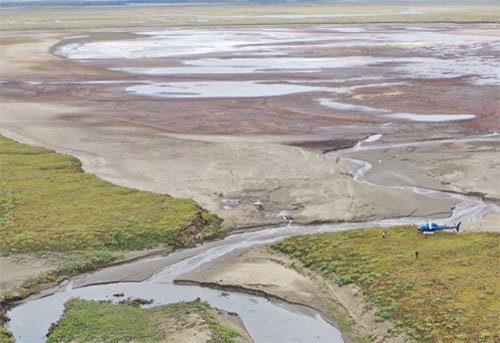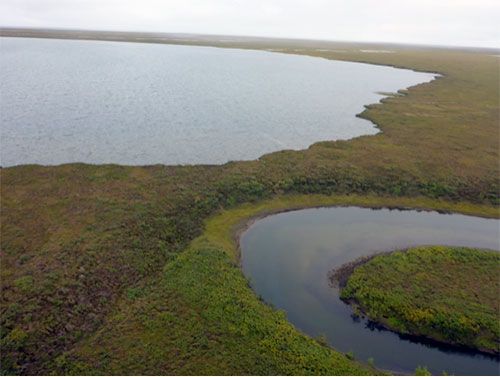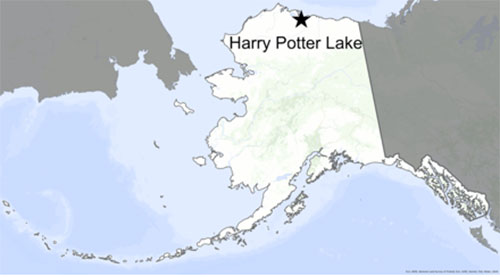Harry Potter Lake, pictured in this drone photo, lies mostly empty after its water drained into a nearby creek on Alaska’s North Slope in early July 2022. |
Scientists know this because they were watching the lake with game cameras and satellite images.
Chris Arp, of the University of Alaska Fairbanks Water and Environmental Research Center, named Harry Potter Lake because his daughter was enjoying the book series when he first encountered the lake. It also somewhat resembles a wizard’s hat when seen from above.
Arp and other scientists were monitoring the lake because it’s in an area oil companies are considering for development. The lake was large enough that while standing on one side of the water-filled oval in that flat, buggy landscape, you could not see the far shore.
During fieldwork four years ago, Arp noticed that the lake basin was perched 10 feet above the creek level. If gravity had its way, lake water would some day make it into the creek.
Arp noticed a trickle of water between the lake and the river in summer 2021. When he returned this summer, the water was doing its thing.
“By late June that water had begun to cut a major niche, which increased the flow and caused it to erode even faster,” Arp said from Deadhorse after returning from the lake basin in mid-August. “We realized then it was going to go soon.”
Harry Potter Lake, at the top of this photo, perches 10 feet above and 30 feet away from Judy Kayaak Creek that in this 2018 photo. |
Judy Kayaak Creek — the nearby stream that received all that water — flows into larger drainages that empty into the Arctic Ocean northwest of the village of Nuiqsut.
On July 7, 2022, the erosive power of the water cut a new channel, sending a torrent of lake water flooding into the creek.
Judy Kayaak Creek pirated almost the entire volume of Harry Potter Lake in about 24 hours. The creek raged with 100 times its normal volume during the peak flow.
“It was probably strong north winds in early July that ultimately pushed enough water over that outlet to trigger the failure,” Arp said.
Alaska’s treeless North Slope is peppered with lakes that have formed because of surface water that thaws frozen ground. Those lakes have emptied themselves for at least 10,000 years or so, leaving behind scars on the landscape and a fertile place for new plants.
A map shows the location of Harry Potter Creek on Alaska's North Slope. |
Drained lake basins make up more than half of the Arctic coastal plain, the part of the Alaska map that most resembles Swiss cheese.
The disappearance of Harry Potter Lake is “kind of a tree falling in the forest type of thing,” according to Arp. Rarely do people get to see it.
And no one saw the breach this time — except for the cameras standing on posts near the new outlet of the lake and satellites orbiting 500 miles overhead.
Meteorologists at the National Weather Service warned the residents of the village of Nuiqsut, who might have fish camps along the creek, to be watchful for the sudden pulse of water (which did no reported damage).
Other living things have noticed the absence of Harry Potter Lake. Arp flew over the basin one last time on Aug. 15. He noticed it was full of ducks, shorebirds and other waterbirds attracted for some reason to the ponded, muddy lake bed.
“It was kind of amazing how fast they moved in,” he said.
| Since the late 1970s, the University of Alaska Fairbanks' Geophysical Institute has provided this column as a public service in cooperation with the UAF research community. Ned Rozell [ned.rozell@alaska.edu] is a science writer for the Geophysical Institute. |
Representations of fact and opinions in comments posted are solely those of the individual posters and do not represent the opinions of Sitnews.
Send a letter to the editor@sitnews.us
SitNews ©2022
Stories In The News
Ketchikan, Alaska
Articles & photographs that appear in SitNews are considered protected by copyright and may not be reprinted without written permission from and payment of any required fees to the proper freelance writers and subscription services.
E-mail your news & photos to editor@sitnews.us
Photographers choosing to submit photographs for publication to SitNews are in doing so granting their permission for publication and for archiving. SitNews does not sell photographs. All requests for purchasing a photograph will be emailed to the photographer.



